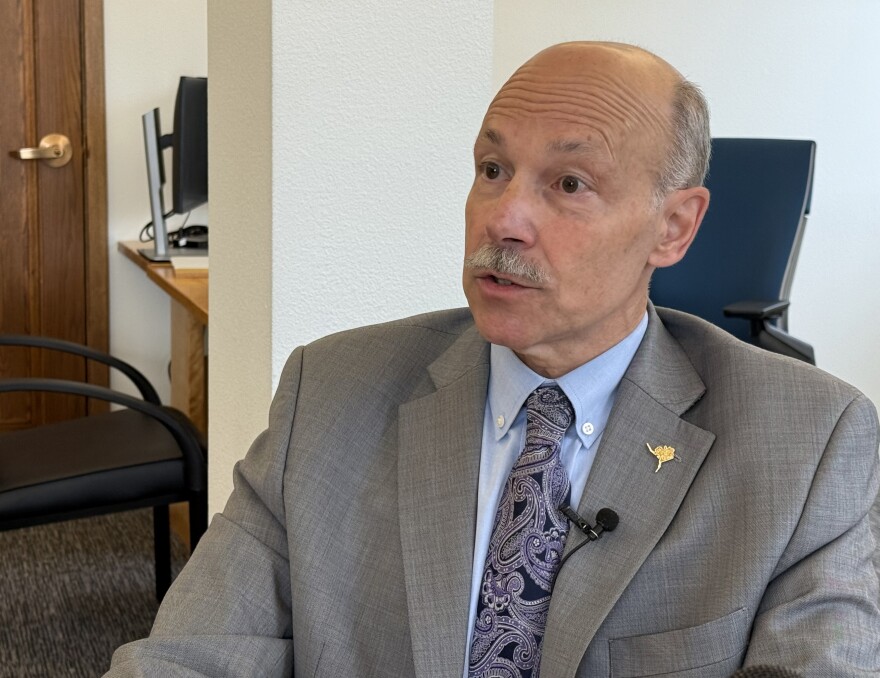Former U.S. Ambassador at-large for Arctic Affairs Mike Sfraga began his one-year tenure as the interim chancellor at the University of Alaska Fairbanks on Monday.
Sfraga assumed the role from departing chancellor Dan White, who announced in early June he was retiring from the post after eight years. White’s last day was Sunday, though he will remain at UAF as a civil engineering faculty member.
Sfraga told reporters Monday that it’s an honor to serve as interim chancellor, but he said he decided against candidacy for the permanent position because he wants to continue focusing on Arctic and foreign policy.
“That remains a very important thing for many of us to work on,” he said. “And you cannot do it at the level I have been, and the level that I’d like to, while still being chancellor. It’s unfair to the institution.”
Sfraga said he does plan to make small changes and look for ways to innovate while he’s leading the research university. But he said, for the most part, he intends to keep UAF on its current course.
“I look at it as a highway: There are guardrails and there are different lanes, and so I will be in the lanes. I’m not looking to move the guardrails out,” he said.
Sfraga earned a Ph.D. in geography and northern studies from UAF and has a roughly 30-year history working in the UA system, from 1985 to 2016, as a faculty member and in various executive and administrative roles.
He was nominated as Ambassador at-large to the Arctic by then-President Joe Biden in 2023 and confirmed by the Senate in 2024. He customarily resigned from the post this January just before President Donald Trump took office and was not reappointed.
He’s also chaired the U.S. Arctic Research Commission and was a founding director of the Polar Institute, a platform for workshops, forums and papers that address policy challenges in polar regions.
Sfraga said his background puts him in a good position to leverage domestic and international networks, and he also said the university’s research facilities and faculty are well-placed to make the most out of growing interest in the Arctic.
“Look, we’ve spent a hundred years building an institution whose time has come,” he said. “This is the time.”
In a July 18 news release announcing Sfraga as the interim chancellor, UA President Pat Pitney said “he will be an excellent leader and steady hand at the wheel as we commence a search for a permanent chancellor.”
The interim chancellor joins the university at a time when it’s aiming to graduate more and more PhDs amid its ongoing quest for R1 status, a tier in the Carnegie classification system reserved for top research universities.
A UAF fact sheet says the university estimates R1 status would bring a 7% to 9% increase in enrollment and create 800 to 1,000 new jobs.
But attaining the status requires having at least $50 million in annual research activity and graduating an average of 70 PhDs over a three-year review period. The university currently quadruples the minimum in research dollars, but in the last review period, from FY21-FY23, UAF graduated 34 PhDs.
And the push to double that number is facing some federal headwinds, with President Donald Trump and his administration proposing major cuts to agencies that support UAF research, like the National Science Foundation (NSF), U.S. Geological Service (USGS), National Weather Service (NWS) and National Oceanic and Atmospheric Administration (NOAA).
However, early signs from House and Senate appropriations committees suggest Congress could split from the president, opting for smaller reductions to the agencies’ budgets.
Sfraga said he will be working alongside other university leaders and visiting Washington D.C. as Congress works through the appropriations process this summer and fall to advocate for funding agencies that support UAF research.
“We have to make the argument better,” he said. “I know that there are members of Congress who are interested in preserving components of the federal funding for areas like NSF and NOAA, and elsewhere.”
In a farewell letter to the university community, departing chancellor Dan White said “nothing is more important” to UAF’s research and long-term stability than enrollment.
Enrollment at UAF hovered around 10,000 students in 2010, according to university data. It’s flattened out at around 7,500 students over the last few years after a steady decline.
In his letter, White wrote that a proliferation of class caps and waitlists is turning away hundreds of students each year.
“They just go somewhere else when a class presents as full. They are gone,” he wrote, adding that 100 full-time students equates to about $1 million in revenue for the university.
Sfraga says he hasn’t yet assessed that issue yet, but that he has taken note of it and plans to dig into it further during his tenure.


